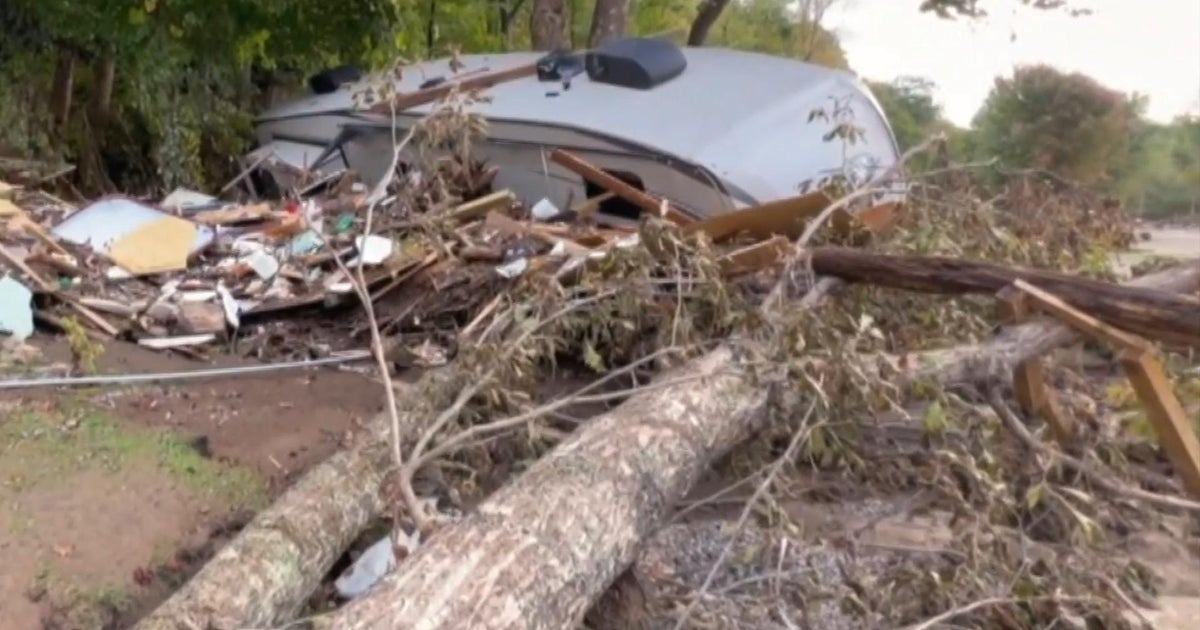CBS News
Hurricane Helene conspiracy theories about lithium mining, weather control spread widely

In the wake of Hurricane Helene, false rumors about the federal response have spread rapidly on social media. More extreme conspiracy theories have also taken root, including claims that politicians manipulated the weather to target Republican areas and that the government is trying to seize land in North Carolina to mine lithium.
The false claims have been amplified by high-profile politicians and social media influencers with large followings. Despite gaining millions of views online, these claims have been debunked by officials and experts, who stress that the government response remains focused on recovery efforts in the hardest-hit regions. Here are two fact checks about the main claims.
False claim: The government controlled the weather to make Helene hit Republican areas
The false claim that the government controlled the weather to manipulate Helene’s path to hit majority Republican areas has racked up millions of views on social media.
Georgia Rep. Marjorie Taylor Greene posted on X , saying: “Yes they can control the weather. It’s ridiculous for anyone to lie and say it can’t be done.” The post, which had more than 40 million views at the time of writing, was also debunked via a Community Note on X.
Greene also posted what she described as a map of areas affected by Helene – in states including Florida, Georgia and the Carolinas – with an overlay showing the area is home to a majority of Republican voters.
Conspiracy theorist Alex Jones also amplified the claim, saying “Bottom line the federal government could have killed the storm in the Gulf of Mexico.” Both Greene and Jones pointed to cloud seeding as evidence that the government controlled Hurricane Helene.
Cloud seeding is a type of weather modification that can improve a cloud’s ability to create rain or snow, according to the Nevada-based Desert Research Institute, which has its own cloud seeding program. Cloud seeding has existed since the 1940s, and dozens of countries have weather modification programs.
Hurricane modification through cloud seeding was explored in the years between 1962 and 1983, but the project ended after seeding was found to be ineffective compared to the natural forces of the hurricane, according to the National Oceanic and Atmospheric Administration.
Conspiracies around cloud seeding routinely appear after major weather events, including flooding in Dubai and storms in California. When asked if cloud seeding played a role in the Dubai floods, a meteorologist told the Associated Press “…when it comes to controlling individual rain storms, we are not anywhere close to that.”
False claim: The government is seizing land in a North Carolina town to allow lithium mining
False claims that authorities are trying to seize Chimney Rock, North Carolina, to commandeer a lithium mine have spread on social media platforms like X, TikTok and Facebook.
Some of the rumors cite an alleged “town meeting” where officials said they would bulldoze Chimney Rock and the government would own the land. One post on X spreading the false claim garnered more than 6 million views.
Rutherford County Emergency Management said claims of a government seizure of Chimney Rock “are entirely false,” adding that no “special meeting” was held to discuss seizing the town. Rutherford County Emergency Management clarified that North Carolina lawmakers met with local officials to request federal and state support.
Some social media users spreading the claim referenced the North Carolina city of Kings Mountain, where a lithium mine is projected to reopen. Others reference specific companies like Piedmont Lithium, which aims to build a lithium mine in Gaston County, North Carolina.
These proposed lithium mines are located about 80 to 100 miles away from Chimney Rock.
Local officials are actively working to reconstruct damaged infrastructure in the town. Chimney Rock has posted updates online about its recovery efforts, including rebuilding Main Street, restoring power and clearing debris.
The Federal Emergency Management Agency (FEMA) said in its new “Rumor Response” page that the agency cannot seize a resident’s property or land.
Federal and state officials have said misinformation and conspiracy theories are hindering efforts to provide aid and accurate information to victims.
Deanne Criswell, who leads FEMA, said the false claims are “demoralizing” to aid workers, while Republican Sen. Thom Tillis of North Carolina told “Face the Nation” on Sunday that the claims distract from rescue work.
CBS News
Details on bill to avert government shutdown

Watch CBS News
Be the first to know
Get browser notifications for breaking news, live events, and exclusive reporting.
CBS News
Explosion kills 2 Mexican soldiers in suspected booby trap by drug cartel after troops found dismembered bodies

An improvised land mine apparently planted by a drug cartel killed two Mexican soldiers and wounded five others, Mexico’s defense secretary said Tuesday. Before the blast, the soldiers had discovered the dismembered bodies of three people, officials said.
Gen. Ricardo Trevilla acknowledged that the army had already suffered six deaths from such improvised explosive devices, or IEDs, between 2018 and 2024. But he didn’t specify whether those six had been killed by bombs dropped from drones, or by buried roadside bombs, both of which have been used by gangs in Mexico.
Trevilla said that devices like the one that exploded Monday were “very rustic,” and officials in the past have described them as similar to buried pipe bombs. There was no immediate information on the condition of the five wounded in the attack, which included at least one officer.
Trevilla’s description of the location where the two soldiers died Monday in the western state of Michoacan suggested that it may have been a sort of grisly drug cartel booby trap.
Trevilla said the army sent out a patrol to check on reports that there was an encampment of armed men in a rural area. The armed forces detected an area protected by stockades that appeared to be an encampment, but when soldiers approached in vehicles, they found the trail blocked by logs, so they descended and had to approach on foot.
While approaching, they spotted three dismembered bodies near the encampment, which appeared to be abandoned. But as they drew closer, a buried device exploded and struck the soldiers.
Trevilla blamed the blast on the United Cartels, an umbrella group that includes the local Viagras gang, which has been fighting bloody turf battles against the Jalisco cartel in Michoacan for years.
In August, the Mexican army acknowledged that some of its soldiers have been killed by bomb-dropping drones operated by drug cartels.
Previously, officials have said the army encounters far more roadside bombs than drone-dropped ones.
The Jalisco drug cartel has been fighting local gangs for control of Michoacan for years, and the situation has become so militarized that the warring cartels use roadside bombs or IEDs, trenches, pillbox fortifications, homemade armored vehicles and sniper rifles.
Nemesio Oseguera-Cervantes, also known as “El Mencho,” the leader of the Jalisco cartel, which the officials described as “one of the world’s most violent and prolific drug trafficking organizations.” The United States and the State Department has offered a $10 million reward for his capture.
In the only previous detailed report on cartel bomb attacks in August 2023, the defense department said at that time that a total of 42 soldiers, police and suspects were wounded by IEDs in the first seven and a half months of 2023, up from 16 in all of 2022.
Overall, 556 improvised explosive devices of all types – roadside, drone-carried and car bombs – were found in 2023, the army said in a news release last year.
CBS News
Why the alleged UnitedHealthcare CEO shooter is facing terrorism charge

Watch CBS News
Be the first to know
Get browser notifications for breaking news, live events, and exclusive reporting.







